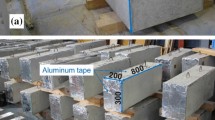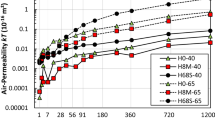Abstract
The report concerns a method of measuring the apparent air permeability in cover concrete and the effects of air flow geometry, cracks and concrete moisture conditions. The method involved pressurizing a 20 mm diameter cavity cut 35 mm deep into the concrete and measuring the rate of pressure decay. A positive testing pressure coupled with the application of liquid soap solution permitted direct observation of air permeation as bubbles. The depth of the cavity was a critical factor and it was desirable to locate the cavity so that its centre-line was at least 40 mm from the nearest lateral surface. Cracks in the concrete increased the permeability and the variability of results. Pore water restricted air permeation through the cover concrete. Moisture conditions were conveniently monitored using a relative humidity probe in the cavity and by measuring weight losses during drying and wetting.
Resume
Il s'agit d'une méthode de mesure de la perméabilité d'air apparente dans le béton d'enrobage et des effets de la géométrie de l'écoulement d'air, des fissures et de l'eau dans le béton. La méthode consiste à pressuriser une cavité de 20 mm de diamètre creusée à 35 mm dans le béton, et à mesurer la vitesse de dépressurisation. Une pression d'air positive assortie de l'application d'une solution savonneuse liquide a permis d'observer directement la pénétration de l'air sous forme de bulles. La profondeur de la cavité étant un facteur critique, il a paru avantageux de faire en sorte que la ligne médiane de cette cavité se situe à 40 mm au moins de la plus proche surface latérale. Des fissures dans le béton augmentent la perméabilité et la variabilité des mesures. La pénétration d'air dans le béton d'enrobage est gênée par l'eau interstitielle. On a établi un contrôle commode des conditions d'humidité en utilisant une sonde de mesure d'humidité relative dans la cavité et en mesurant les pertes de poids pendant le séchage et l'humidification.
Similar content being viewed by others
References
Hilsdorf, H., ‘Durability of concrete—a measurable quantity?’, in Proceedings of IABSE Symposium on Durability of Structures, Lisbon, 1989, Vol. 1, pp. 111–123.
Figg, J., ‘Concrete surface permeability: measurement and meaning’,Chemistry and Industry No. 21 (1989) 714–719.
Kasai, Y., Matsui, I. and Nagano, M., ‘Relationship between carbonation and air permeability of concrete,’Trans. Jpn. Concr. Inst. 6 (1984) 171–178.
Nagataki, S., Ujike, I. and Konishi, N., ‘Influence of moisture content on air permeability of concrete’, in Review of 40th Meeting of Cement Association of Japan, Tokyo, 1986, pp. 158–161.
Parrott, L., ‘Characteristics of surface layers that affect the durability of concrete’, in Proceedings of Engineering Foundation Conference on Advances in Cement Manufacture and Use, Potosi, USA, 1988, pp. 137–142.
Kasai, Y., Matsui, I., Fukushima, Y. and Kamohara, H., ‘On the air permeability of asbestos cement sheet and cement mortar’, in Review of 36th Meeting of Cement Association of Japan, Tokyo, 1982, pp. 224–226.
Parrott, L., ‘Moisture profiles in drying concrete’,Adv. Cement Res. 1(3) (1988) 164–170.
Chen Zhang Hong and Parrott, L., ‘Air permeability of cover concrete and the effect of curing’, British Cement Association Report C/5 (1989).
Parrott, L., ‘Assessing carbonation in concrete structures’, 5th International Conference on Durability of Building Materials and Components, Brighton, November 1990, pp. 575–586.
Kasai, Y., Matsui, I. and Kamohara, H., ‘Method of rapid test for air permeability of structural concrete’,Trans. Jpn. Concr. Inst. 5 (1983) 97–104.
Author information
Authors and Affiliations
Rights and permissions
About this article
Cite this article
Parrott, L., Hong, C.Z. Some factors influencing air permeation measurements in cover concrete. Materials and Structures 24, 403–408 (1991). https://doi.org/10.1007/BF02472013
Issue Date:
DOI: https://doi.org/10.1007/BF02472013




